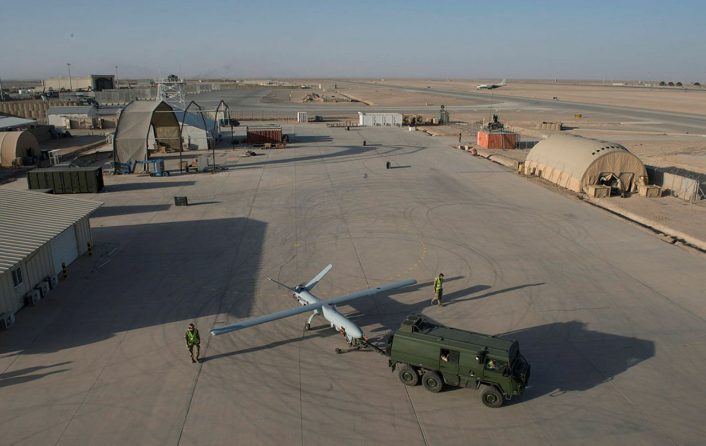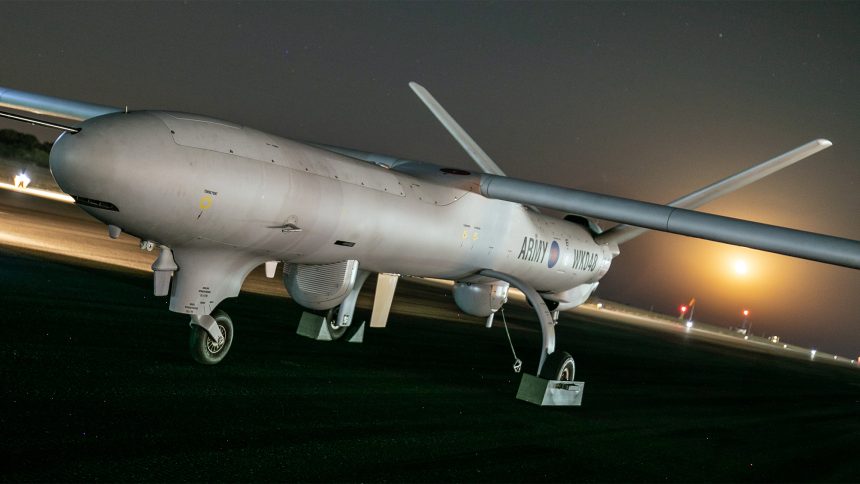The British Army’s Watchkeeper UAV, originally intended to leave service in March 2025, has had its troubled service life extended to March 2027, while procurement for successor platforms remains in the early stages.
The Ministry of Defence (MoD) announced in November 2024, as part of a wider series of cuts, that the British Army’s Watchkeeper intelligence, surveillance, target acquisition, and reconnaissance (ISTAR) drone would be retired from service ahead of schedule. Initially this was expected to take place by March 2025, but continued operation of the aircraft from a number of locations had already shown that deadline had been missed. A contract for the provision of maintenance services for the Watchkeeper fleet issued in April 2025 indicated that the expected withdrawal date would instead be March 2026.
Member of Parliament Luke Pollard, Minister of State for Defence Readiness and Industry, has now revealed in response to a written question that the presently scheduled out of service date (OSD) for Watchkeeper is set for March 2027. The previously mentioned contract already included a clause that allowed such an extension in kind if necessary.
British Army #Thales #Watchkeeper #UAV seen over #Stonehenge. Now routinely flying over southern UK. pic.twitter.com/Yb075D3nAN
— Gareth Jennings (@GarethJennings3) June 2, 2015
Proposals for a replacement aircraft are being sought from the industry by the MoD under Project Corvus. The tender notice for Project Corvus was released on Jul. 31, 2025, with an expected contract value of £130 million. Industry submissions were invited up to the deadline of Aug. 18, and a decision is expected around Mar. 31, 2026. The contract will then run from May. 1, 2026 to Apr. 30, 2031, with an optional five year extension running until Apr. 30, 2026.
The Watchkeeper’s primary role as part of the wider British Army inventory is known as Land Tactical Deep Find, or LTDF, essentially acting as a way to extend the ISTAR horizon for deployed ground forces. As such, the UAV was operated by 47 Regiment Royal Artillery. The aircraft’s general intelligence, surveillance, and reconnaissance (ISR) capabilities were also employed over the English Channel to assist civilian border enforcement agencies.

Any replacement aircraft is expected to match Watchkeeper’s LTDF capabilities while improving upon survivability in contested airspace, including areas subject to electronic warfare and GPS jamming attacks. The new platform must be able to be operated in line with current 47 Regt staffing levels, with minimal change to current training practices. It must also be easily adaptable and upgradeable to match emerging threats and technological developments. A number of companies are expected to have submitted bids, with one key contender thought to be Tekever, who have made huge inroads in terms of unmanned capabilities and have established a significant presence within the UK.
Birth of a #Watchkeeper #UAV
Now fully operational in Camp Bastion #Afghanistan with #BritishArmy#Thales pic.twitter.com/cQ3IrhwBfo
— Tom Antonov (@Tom_Antonov) September 29, 2014
Watchkeeper’s Woes
Watchkeeper, a Thales product, is a derivative of Elbit’s Hermes 450 UAV, in service since 1998. Despite using an established type as its basis, Watchkeeper’s entry into full UK military service was notoriously plagued by delays, crashes, and budget overruns. Ordered in 2007, the first UK flight of a Watchkeeper aircraft took place in 2010. A certification from the Military Aviation Authority followed in 2014, and the aircraft was rushed into operational service over Afghanistan alongside leased Hermes 450 drones.
Poor weather in the UK saw training and trials moved to Ascension Island. By 2018, the programme was £200 million over its intended budget, and, of the 54 aircraft ordered, five had already been lost in crashes. Further losses continued to mount up over the following years.
#UK safety watchdog highlights Watchkeeper #UAV shortfalls https://t.co/ijzdtyPfbU pic.twitter.com/v62GIrjBIZ
— Janes (@JanesINTEL) April 23, 2019
After the announcement of the aircraft type’s early withdrawal, Vernon Coaker, Baron Coaker, Minister of State in the Ministry of Defence, told the House of Lords that “that system has been in service since 2010 and, according to all the military chiefs, is out of date.” He added that lessons learned from the war in Ukraine have signaled that a new capability is needed. Prior to the November 2024 announcement, Watchkeeper was expected to serve in the British Army until 2042.
This was echoed by voices within the military, who told reporters and ministers that the aircraft are “no longer fit for operational purpose”. Though on the surface an odd comment to make regarding a platform that has only in the last few years been a readily deployable capability, Watchkeeper’s origins in the conflicts facing the UK two decades ago reveal its age and its weaknesses. Now looking at the prospect of peer on peer conflicts, rather than fights against insurgencies, the British Army, and the wider British military, is attempting to consolidate its capabilities and take advantage of new technologies and tactics that were almost unthinkable even ten years ago.
Unlike more modern equipment, designed from the outset with modularity and upgradeability as key features, Watchkeeper’s pathways to incorporate new systems, and even software, would likely be much more expensive and laborious.
These problems, for a successful platform, might be able to be overlooked. But for Watchkeeper, which, as reported by Amelia Smith for The War Zone in 2023, recorded only 1,191 flying hours across a four year period between 2018 and 2022 – far short of the desired 6,000 flying hours per year – they were just more reasons to declare the platform obsolete before it ever got a true test on the frontline.









